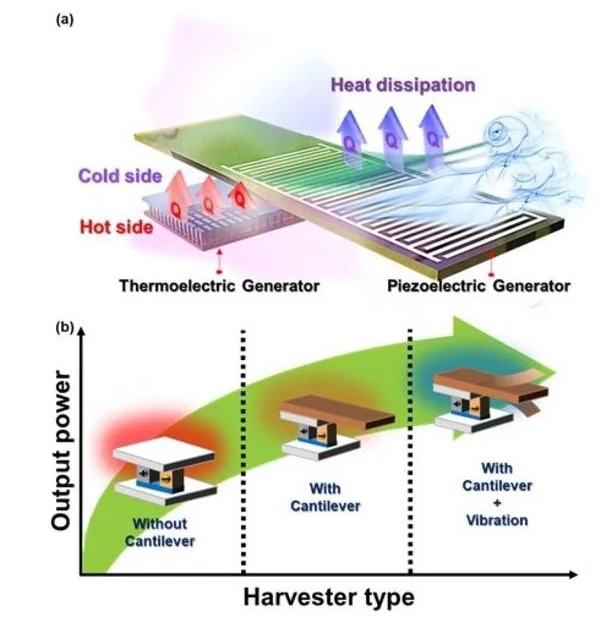Energy harvesting is the process of obtaining electrical energy from common energy sources such as heat, vibration, light, and electromagnetic waves from places like factories and cars. Today's widespread IoT sensors and wireless devices, which are often placed in locations where changing batteries is challenging, can be powered more easily with the help of energy harvesting.
 Thermoelectric-Voltaic Hybrid Harvester Utilizing a Cantilevered Dynamic Heat Sink Developed by KIST Researchers. Image Credit: Korea Institute of Science and Technology (KIST)
Thermoelectric-Voltaic Hybrid Harvester Utilizing a Cantilevered Dynamic Heat Sink Developed by KIST Researchers. Image Credit: Korea Institute of Science and Technology (KIST)
By combining thermoelectric and piezoelectric effects, Dr. Hyun-Cheol Song and Dr. Sunghoon Hur of the Korea Institute of Science and Technology (KIST) have developed a hybrid energy harvesting system that increases power production by more than 50%.
It is impossible to consistently harvest energy due to the low energy conversion efficiency of the thermoelectric effect, which transforms thermal energy from both ends of the device into electrical energy, and the high impedance of the piezoelectric effect, which transforms mechanical vibration into electrical energy.
Hybrid energy harvesters have been proposed previously to overcome the drawbacks of single-mode energy harvesters; however, their primary method consists of merely combining the energy produced by each mechanism.
In response, the KIST research team created a hybrid energy harvester that combines the benefits of piezoelectric and thermoelectric technologies while addressing their shortcomings to produce a synergistic effect in vibration- and heat-producing environments.
Firstly, to enhance the heat dissipation effect in a vibration environment, a cantilever was constructed in place of a heat sink, which is a static shape with a large cross-sectional area that is bulky and in contact with air. This improved thermoelectric device output by more than 25%.
Additionally, the researchers proposed a hybrid energy harvesting structure in which the cantilever was attached to a polymer-type piezoelectric device (MFC) that generates additional power through tensile and compressive deformation when the cantilever shakes. The research team demonstrated the potential for future IoT sensors to run continuously without a battery power supply by successfully using this hybrid energy harvester to drive a commercial IoT sensor (GPS positioning sensor, 3 V, 20 mW).
This study confirms that the hybrid energy harvesting system can be reliably applied to our real life. We have confirmed its effectiveness in places where heat and vibration exist together, such as automobile engines, and are currently planning to build a system that can be applied to factory facilities or construction machinery engines that are difficult to supply power and diagnose their condition wirelessly.
Dr. Sunghoon Hur, Lead Researcher, Korea Institute of Science and Technology
Journal Reference:
Kim, S.-B., et al. (2023). A synergetic effect of piezoelectric energy harvester to enhance thermoelectric Power: An effective hybrid energy harvesting method. Energy Conversion and Management. doi.org/10.1016/j.enconman.2023.117774.